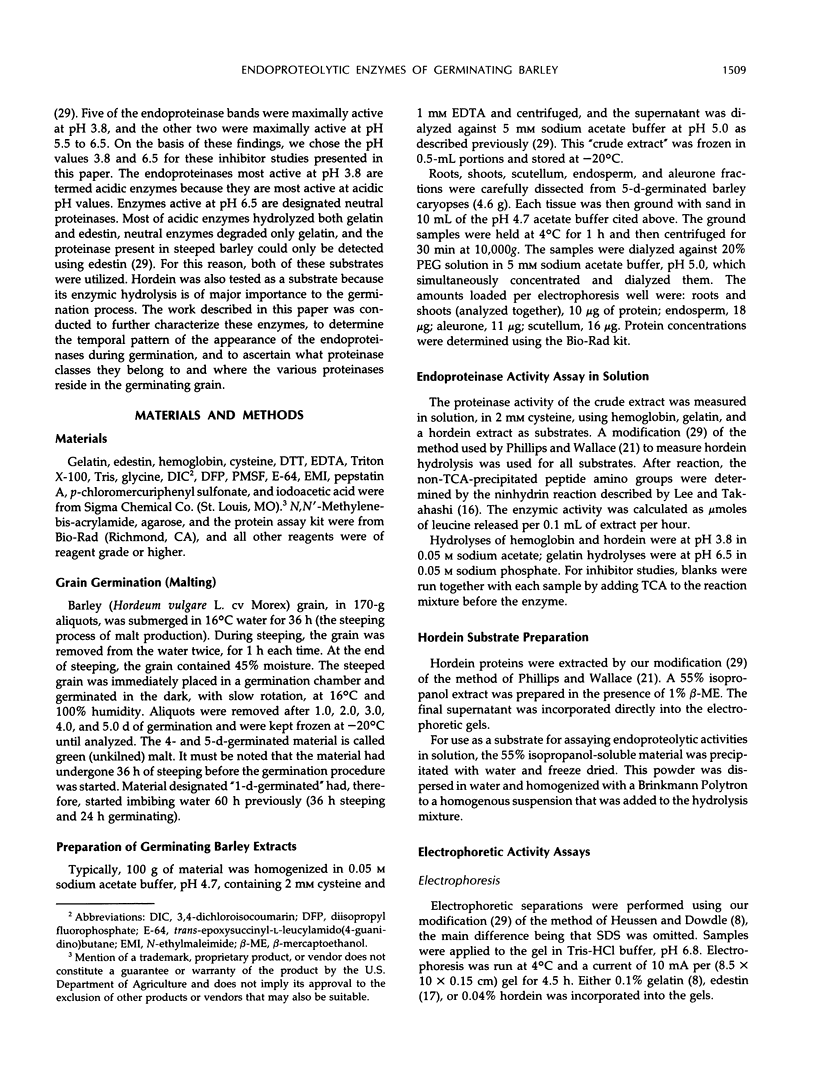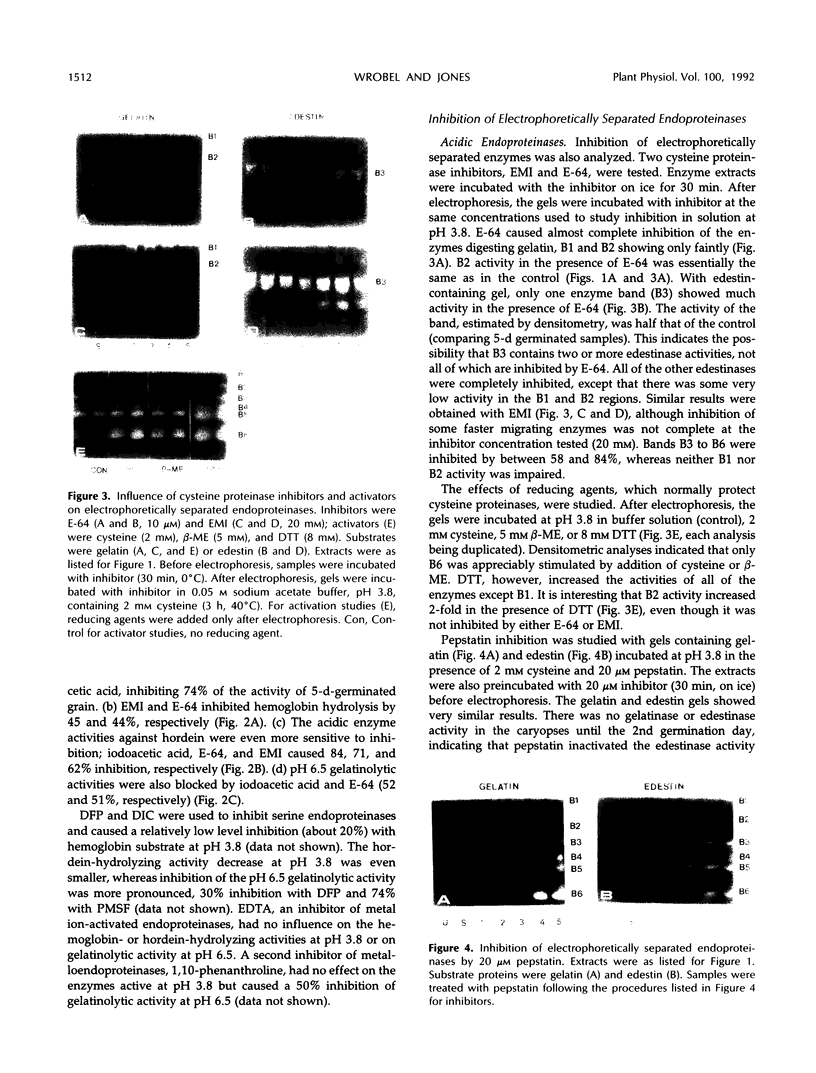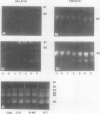Abstract
Barley endoproteolytic enzymes are important to germination because they hydrolyze endosperm storage proteins to provide precursors for new protein synthesis. We recently developed an electrophoretic method utilizing gel-incorporated protein substrates to study the endoproteinases of 4-d-germinated barley (Hordeum vulgare L. cv Morex) grain. This work extends those findings to determine the temporal pattern of the appearance of the endoproteinases during germination, the sensitivities of the proteinases to class-specific proteinase inhibitors, and where, in germinating caryopses, the proteinases reside. Six endoproteinase activity bands (representing a minimum of seven enzymes) were present in 5-d-germinated barley grain extracts subjected to electrophoresis in nondenaturing gels at pH 8.8. The activities of two of the enzyme bands (“neutral” proteinases) increased as the pH was increased from 3.8 to 6.5. The activities of the remaining four (“acidic”) bands diminished abruptly as the pH increased above 4.7. Two proteinase bands hydrolyzed gelatin but not edestin, four of the proteinases hydrolyzed both gelatin and edestin at nearly the same rates, and one enzyme degraded only edestin. One neutral endoproteinase was sensitive to diisopropyl fluorophosphate inhibition, and the other was not inhibited by any of inhibitors tested. Four of acidic enzymes were cysteine proteinases [inhibited by trans-epoxysuccinyl-l-leucylamido(4-guanidino)butane and N-ethylmaleimide]; the other was an aspartic acid endoproteinase (sensitive to pepstatin). Only the aspartic proteinase was detected in either ungerminated or steeped barley grain. During the germination (malting) process, the aspartic endoproteinase activity decreased until the second day of germination and then increased until germination day 5. The first endoproteinase(s) induced during germination was a neutral enzyme that showed activity on the 1st day of the germination phase after steeping. Most of the endoproteinases became active on the 2nd or 3rd germination day, but one cysteine proteinase was not detected until the 5th day. Acid cysteine proteinases were present in the aleurone, scutellum, and endosperm tissues but not in shoots and roots. The aleurone layer and endosperm contained almost exclusively band B1 neutral proteinases, whereas the scutellum, shoots, and roots contained both B1 and B2 bands. This work shows that germinating barley contains a complex set of proteinases whose expression is temporally and spatially controlled. But, at the same time, it also shows that this electrophoretic method for separating and studying individual enzymes of this complex will allow us to more readily characterize and purify them.
Full text
PDF








Images in this article
Selected References
These references are in PubMed. This may not be the complete list of references from this article.
- Burger W. C. Multiple forms of acidic endopeptidase from germinated barley. Plant Physiol. 1973 Jun;51(6):1015–1021. doi: 10.1104/pp.51.6.1015. [DOI] [PMC free article] [PubMed] [Google Scholar]
- Every D. Quantitative measurement of protease activities in slab polyacrylamide gel electrophoretograms. Anal Biochem. 1981 Sep 15;116(2):519–523. doi: 10.1016/0003-2697(81)90396-1. [DOI] [PubMed] [Google Scholar]
- Heussen C., Dowdle E. B. Electrophoretic analysis of plasminogen activators in polyacrylamide gels containing sodium dodecyl sulfate and copolymerized substrates. Anal Biochem. 1980 Feb;102(1):196–202. doi: 10.1016/0003-2697(80)90338-3. [DOI] [PubMed] [Google Scholar]
- Koehler S. M., Ho T. H. A major gibberellic Acid-induced barley aleurone cysteine proteinase which digests hordein : purification and characterization. Plant Physiol. 1990 Sep;94(1):251–258. doi: 10.1104/pp.94.1.251. [DOI] [PMC free article] [PubMed] [Google Scholar]
- Koehler S. M., Ho T. H. Hormonal regulation, processing, and secretion of cysteine proteinases in barley aleurone layers. Plant Cell. 1990 Aug;2(8):769–783. doi: 10.1105/tpc.2.8.769. [DOI] [PMC free article] [PubMed] [Google Scholar]
- Koehler S., Ho T. H. Purification and characterization of gibberellic Acid-induced cysteine endoproteases in barley aleurone layers. Plant Physiol. 1988 May;87(1):95–103. doi: 10.1104/pp.87.1.95. [DOI] [PMC free article] [PubMed] [Google Scholar]
- Poulle M., Jones B. L. A Proteinase from Germinating Barley : I. Purification and Some Physical Properties of a 30 kD Cysteine Endoproteinase from Green Malt. Plant Physiol. 1988 Dec;88(4):1454–1460. doi: 10.1104/pp.88.4.1454. [DOI] [PMC free article] [PubMed] [Google Scholar]
- Rastogi V., Oaks A. Hydrolysis of storage proteins in barley endosperms : analysis of soluble products. Plant Physiol. 1986 Jul;81(3):901–906. doi: 10.1104/pp.81.3.901. [DOI] [PMC free article] [PubMed] [Google Scholar]
- Sopanen T. Development of Peptide Transport Activity in Barley Scutellum during Germination. Plant Physiol. 1979 Oct;64(4):570–574. doi: 10.1104/pp.64.4.570. [DOI] [PMC free article] [PubMed] [Google Scholar]







